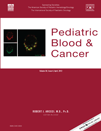Comparison of piperacillin tazobactam and cefoperazone sulbactam monotherapy in treatment of febrile neutropenia†
Conflict of interest: Nothing to declare.
Abstract
Background
Monotherapy has tended to replace the combination therapy in emprical treatment of febrile neutropenia. There is no reported trial which compares the efficacy of cefoperazone-sulbactam (CS) and piperacillin-tazobactam (PIP/TAZO) monotherapies in the treatment of febrile neutropenia. In this prospective randomized study, we aimed to compare the safety and efficacy of CS versus PIP/TAZO as empirical monotherapies in febrile neutropenic children with cancer.
Procedure
The study included febrile, neutropenic children hospitalized at our center for cancer. They were randomly selected to receive CS 100 mg/kg/day or PIP/TAZO 360 mg/kg/day. Duration of fever and neutropenia, absolute neutrophil count, modification, and success rate were compared between the two groups. Resolution of fever without antibiotic change was defined as success and resolution of fever with antibiotic change or death of a patient was defined as failure. Modification was defined as changing the empirical antimicrobial agent during a febrile episode.
Results
One hundred and two febrile neutropenic episodes were documented in 55 patients with a median age of 4 years. In 50 episodes CS and in 52 episodes PIP/TAZO was used. Duration of fever and neutropenia, neutrophil count, age, sex, and primary disease were not different between two groups. Success rates in the CS and PIP/TAZO groups were respectively 56 and 62% (P > 0.05). Modification rate between two groups showed no significant difference (P > 0.05). No serious adverse effect occurred in either of the groups.
Conclusion
CS and PIP/TAZO monotherapy are both safe and effective in the initial treatment of febrile neutropenia in children with cancer. Pediatr Blood Cancer 2012; 58: 579–583. © 2011 Wiley Periodicals, Inc.




